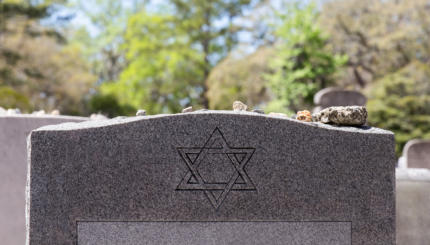The Book of Departure, published in 1930, is a collection of end-of-life stories of late 18th and 19th century eastern European Hasidic rabbis. It is a trove of remarkable Jewish wisdom on a subject many find difficult to discuss.
Hasidism, a mystical and charismatic tradition, frequently employs stories because they invite us into timeless situations and emphasize the most human moments. Part of our people’s collective myths, Torah and bubbe meises (grandparents’ tales), these stories can deepen our understanding and provide meaning for that which is most hidden from us at times: ourselves.
Hasidic stories and wisdom offer resources and frameworks as we seek ways to navigate the end of life with people we love, and someday, for ourselves. How can we die or accompany others at death in ways that strengthen our connection to those we love, illuminate our connection to what we find sacred, and bring peace into the world?
Here are several Hasidic ideas that can bring comfort to you and your loved ones.
With your help, My Jewish Learning can provide endless opportunities for learning, connection and discovery.
Acknowledge that There’s No Single Way to Understand Death
The Hasidim don’t use the word “death” when describing the final moments of their rabbis. The words they use include: departure, lying down, hiding, sleeping, being taken by God. Each of these points to a potentially different understanding of death. The Hasidim shared a range of beliefs about death with their disciples, imagining it to be everything from rejoining dearest friends and family in a heavenly hall of study to absolute nothingness. There is no one right way to think about it.
It can be helpful to take time to consider honestly what you believe about your own death, and create space and acceptance in yourself for this. Likewise, find the quiet that is needed for others to share what they believe will happen when they die. To be present with another person at this critical time is to hear them, walk with them in their reality and not to teach or convince.
Create a Circle Around the Dying
The Hasidic rabbis described people gathering, visiting and companioning a person as they near their death, and this is something we can do as well. Busy days, the medical needs of a dying person, great distances and also our personal discomfort may result in loved ones not being there to surround a person toward the end of their life. But it’s worth making the effort.
The founder of Hasidism, the Baal Shem Tov (and many after him) brought his chosen people close to him and gave them directions on how to care for him in the moment of his death and also after his departure. His primary concern was kindness: “Until now I have acted with loving-kindness toward you; now it is time for you to reciprocate.”
Death is a time of ultimate hesed, flowing loving kindness (this word shares the same root as the word “Hasidism”). The Hasidim teach that it is God who has taught us about hesed, not any one individual. We draw from the kindnesses we have received to offer only love.
How to Cope with End-of-Life Dementia
In the description of the death of Rabbi Yechiel of Zlotshov, we see someone who was perhaps suffering from dementia:
“Two years before his departure R. Yechiel Michel of Zlotshov was already completely separated from this world, and it was necessary to watch over him so that his soul would not leave from its great cleaving with the Creator.”
His family offers a remarkable interpretation of his dementia: his soul had already joined God.
Many elders suffer from dementia and those who love them also struggle, grieving the personality and memories of the person as they slip away. The loved one is still alive, but a critical aspect of their person is gone. If we can learn to see them as having entered a sacred place where they are not alone but rather have a growing closeness to something much bigger, perhaps we can be more at peace, and help them also be at peace.
Unify the Family
On his deathbed, Rabbi Dov Baer of Mezeritch said:
“My children, hold yourselves together as one, and thereby you will overcome everything.”
He was speaking to his children and disciples together.
Too often people can become polarized and divided around the death of a parent or beloved elder. When a dying person can direct and facilitate the unity of the family it is a tremendous gift to all. Rabbi Dov Baer implored them to support one another, and be good to themselves. With these words he passed on his love and brought them to a more soulful place.
Don’t Make Death a Taboo Subject
At times a long illness, or a very long life, can give a person time to speak more about death. Rabbi Yitzchak Isaac of Zhiditchov began talking about his death several years before he died, describing it as “standing on the threshold of the world of truth.” His story challenges us all to embrace honesty and open discussion when it comes to death.
Talking about death doesn’t mean the mood must always be somber. Rabbi Yitzchak Isaac modeled a path of embodying joy and the life of the spirit up until he was very weak at which point he offered blessings to all who came to see him. Some of us know people like this, or are living this ourselves. This is when personal wisdom, and strength of spirit help one be a guiding light to all around them.
Create a Final Home for the Dead
The Hasidic rabbis speak about wanting to be buried in the vicinity of people they have known and loved in life — reminding us of the importance of cemeteries. Speaking of death, the Torah often says that a person “was gathered to his people” — a phrase that, taken literally, transcends time and place. A cemetery provides an embodied understanding of being “gathered to one’s people” and the knowledge that it will be a place to visit can provide comfort in a very essential way both for the person dying, and for those remaining in life.
Make Room for Joy
The final teaching I will share here is a hard one. There is a Hasidic belief that the day of death should be a day of celebration. The dying person has completed the journey of life and is now returning to God, to a oneness with the universe.
“R. Shmuelke, son of R. Mose Leib of Sasov — his departure was a wondrous joining with God — with unfathomable ecstasy.”
This can be hard to wrap our hearts around, and it can be hard to feel joy even when honoring the Yahrzeit, the annual memorial of the day of death.
But there is also no reason to wait until the end. In our own lives, each day as we age and approach death, can we feel and express gratitude for every day’s gifts? This is a Hasidic priority. Maybe with practice, day by day through life, we will build the strength to give thanks, and be at peace with the sum of our days when that time comes. This will impart to those we leave behind the fullness and completeness of a life well lived.
As in life, in death there are no guarantees. There are stories of Hasidic rabbis who were filled with sadness at the end of life. In these cases, it is sometimes the rabbi’s continued teaching, contributing until the very end, that gives them and their loved ones some comfort and emphasizes their legacy. For all who are sad or clinically depressed in their final weeks, months and possibly years, we are taught to stay loyal and present. We come together, gather round, joining with the dying person to create a oneness that is bigger and stronger than death itself.
Want more? MJL’s “Discovering Jewish Spirituality” email series will guide you through authentic Jewish methods of bringing spirituality into your everyday experience. Sign up here.
Enhance your spirituality journey by joining our weekly Jewish Meditation Moment for a brief Jewish teaching followed by a guided meditation.


